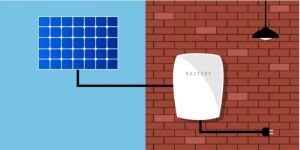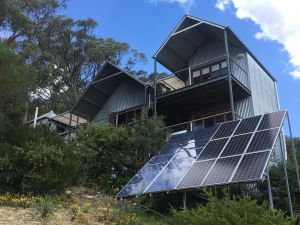Solar battery storage technology is generating a lot of discussion within the energy industry – and for good reason. It’s been hailed as the future of electricity, and given Australia has one of the highest penetrations of rooftop solar panels in the world, we’ve fast become a focus-market for many retailers.
Concerns over increasing electricity costs have led many Aussie households to turn to renewable energy solutions, such as solar storage, as an alternative to drawing power from the grid. But are solar batteries really worth it? Canstar Blue investigates.
On this page:
Advertisement
How do solar batteries work?
Solar batteries essentially work as a storage unit for excess solar power that’s been generated by photovoltaic (PV) panels. This works in a similar process to that of solar feed-in tariffs, wherein the energy generated by solar panels during daylight hours is first put to use in homes or businesses. However, instead of then sending any leftover solar energy back into the grid in exchange for a credit, in the case of a solar battery, any additional output is then sent to a storage unit for use during evening hours when sunlight is no longer prevalent.

Solar storage systems can be installed within a solar panel system from the initial set-up or incorporated later down the track. However, you may be required to install an additional solar inverter to help support your solar battery. If you have a hybrid solar inverter though, you’ll generally be able to incorporate a battery straight into your existing system.
The main concept of a solar battery is to extend the amount of time solar energy can be used for. With a typical solar panel system set-up, energy can only be generated and used within daylight hours, or when direct sunlight is beaming on the panels. A battery or storage unit then allows households and businesses to maximise their solar energy outside of these restrictions, further reducing their reliance on grid energy, which in turn can potentially help reduce power bills and carbon emissions.
How much does a solar battery cost?
As a general rule of thumb, solar battery storage prices in Australia cost between $1,000 – $2,000 per kilowatt hours (kWh) of storage capacity – e.g., $4,000-$8,000 for a 4kWh battery. The final cost however, will largely depend not only on the storage size but also the quality of the products chosen, installation costs and of course, whether you’ll also need to install solar panels on your rooftop. A solar panel system installation can cost anywhere from $2,000 to $12,000 depending on system size.
Most states and territories though, now offer solar rebates and discounts to eligible homes and small businesses looking to install batteries or solar storage units. These incentives can help to lower the initial install and purchase costs of the battery system. To see if your state or territory is offering any interest-free loans or rebates for solar storage it is best to visit your relevant government website.
Please note, nearly all solar companies will request a quote before they can give you some idea of how much this will set you back. It might be handy though to compare a range of quotes from different companies before picking a solar installer.
You might also be interested in:
How long do solar batteries last?
Typically, a good quality solar battery can last between five to 15 years before it needs replacing. The way this is measured is through its ‘cycles’ which essentially refers to the process of filling and emptying a battery with electricity. When measuring a life span in years, it’s generally assumed there is one cycle per day. The more cycles there are, the more durable the battery is claimed to be.
Solar Plans & Prices
Here are some of the cheapest solar-specific deals from the retailers on our database. These costs are based on the Ausgrid network in Sydney but prices will vary depending on your circumstances. We show one product per retailer, listed in order of lowest price first. Annual price estimates assume general energy usage of 3911kWh/year for a residential customer on a single rate tariff. Price estimates exclude solar feed-in tariff credits. These are products from referral partners†. Our database may not cover all deals in your area, and please check retailer websites for up to date information.
Here are some of the cheapest solar-specific deals from the retailers on our database. These costs are based on the Citipower network in Melbourne but prices will vary depending on your circumstances. We show one product per retailer, listed in order of lowest price first. Annual price estimates assume general energy usage of 4000kWh/year for a residential customer on a single rate tariff. Price estimates exclude solar feed-in tariff credits. These are products from referral partners†. Our database may not cover all deals in your area, and please check retailer websites for up to date information.
Here are some of the cheapest solar-specific deals from the retailers on our database. These costs are based on the Energex network in Brisbane but prices will vary depending on your circumstances. We show one product per retailer, listed in order of lowest price first. Annual price estimates assume general energy usage of 4613kWh/year for a residential customer on a single rate tariff. Price estimates exclude solar feed-in tariff credits. These are products from referral partners†. Our database may not cover all deals in your area, and please check retailer websites for up to date information.
Here are some of the cheapest solar-specific deals from the retailers on our database. These costs are based on SA Power network in Adelaide but prices will vary depending on your circumstances. We show one product per retailer, listed in order of lowest price first. Annual price estimates assume general energy usage of 4011kWh/year for a residential customer on a single rate tariff. Price estimates exclude solar feed-in tariff credits. These are products from referral partners†. Our database may not cover all deals in your area, and please check retailer websites for up to date information.
Will I save money with a solar battery?
Now for the question everyone is wondering – is a solar battery worth it cost-wise? While they’re marketed as being able to help cut your electricity bill – and they certainly deliver on that – it’s important to remember that solar batteries can be quite a significant financial investment.
Households can spend up to $16,000 on a solar storage unit alone in some cases. This means that – despite the incredible savings on ongoing electricity bills – it’s unlikely the entire solar system could pay for itself before the solar battery’s warranty expires.
Canstar Blue has calculated how much money a solar battery could save you, as well as the time it would take to make a return on your investment below.
Let’s take a national household with a 5kW solar system already installed. The standard four-person national household consumes 23kWh of electricity a day on average. Now let’s assume this property pays an electricity usage rate of 29.2c/kWh, meaning it’ll cost the home $6.72 a day in electricity costs. The home’s 5kW solar system produces about 20kWh of electricity each day, if conditions are optimal. So, for each kWh of power that’s generated from the solar system, the household will be saving 29.2c/kWh. If this household were to add a solar battery…. To complement its current solar system, let’s say the household decides to purchase the Tesla Powerwall 2, which costs around $15,495 for the unit plus installation (excluding the cost of an inverter). The Powerwall 2 can hold 13.5kWh of electricity, but will take around 15kWh of the solar system’s generated 20kWh to fully charge the battery, based on the Tesla Powerwall 2 specs. Of the household’s 23kWh of electricity use each day, 13.5kWh would be stored in the Powerwall 2 to use in the evening, as opposed to relying on the grid, meaning the house would save about $3.94 a day, or approximately $1438 each year in costs from the grid. After charging the battery, the household should still have about 5kWh of energy for use that has been generated by the solar panels. Depending on the lifestyle of the household, this may either be used entirely by members during the day, savings costs on grid energy, or divided between use at the home and exports in exchange for a solar feed-in tariff. For the purposes of this study, we’ll assume that the household uses about 2kWh of their generation each day, saving an additional $213 each year. The remaining 3kWh each day are exchanged for a feed-in tariff of about 7.4c/kWh, equating to around $81 in savings a year. Taking all this into consideration then, the payback time for the solar battery would be around 8 Years, 11 Months… Given that the Powerwall 2 has a 10-year warranty and 15-year life expectancy, this means that the household in this particular situation would be right on the money with their purchase. Please note, if you don’t currently have a solar system installed and paid off, then you will also need to factor in the costs of solar panels.Case Study: Solar Battery Storage
Advertisement
How to get the most out of a solar battery
To maximise the potential savings of a solar battery, it’s important to ensure you have adjusted your energy usage habits to best suit the requirements of your battery and panel system. This might mean looking into a more flexible electricity tariff, such as a controlled load or time of use tariff.
Time of use and other flexible rate tariffs charge different rates at certain times, meaning electricity is usually the cheapest during normal working hours and very late at night. Electricity is more expensive during peak demand times – generally between 4pm and 8pm. Households and businesses on this type of tariff then, may be able to benefit from lower rates for most of the day, and use their stored solar power to cover peak period energy usage, rather than relying on the grid and paying higher peak rates. Most solar storage units can be set to automatically kick in between these hours, while some systems are compatible with apps that let you monitor and control when or how your stored solar power is used.

As for a controlled load tariff, this can also speed-up your solar battery savings as household appliances connected to this tariff only require electricity for a few hours a day, usually late at night. Customers can even connect their solar battery to a controlled load and charge their battery overnight with grid electricity that’s at a cheaper rate. By morning, they can use their charged battery, rather than pay the full price for electricity.
This is not to say however, that customers on a single rate tariff won’t be able to get the same value out of a solar battery. While these kinds of energy consumers can’t tap into varying electricity rates to make the most of their solar battery, there are other ways they can attempt this. For one, they may choose instead to significantly minimise their reliance on the grid – forgoing the need for cheaper grid electricity prices entirely. Another way could be joining a Virtual Power Plant (VPP) network and earning credits for sharing their solar energy during peak demand times.
At the end of the day, making the most out of your solar battery will come down to taking advantage of the options available to your household or business.
Is solar battery storage worth it?
Ultimately, whether it is worth getting a solar battery installed will come down to your personal energy usage habits. While Aussie consumers could get a lot of value from incorporating an energy storage system into their home, it is safe to say the most rewards will be reaped by those who put as much into their system as they expect to get out of it.
Simply installing a solar battery without accommodating your usage habits to best suit the cycles of your system could leave you unfulfilled with the return on your (very expensive) investment. A solar battery works best for home energy usage when it is combatting the typical constraints of the grid, such as higher demand in the evenings or more expensive power prices during peak times. If you are unable or aren’t willing to best utilise your battery to overcome these energy challenges, then you may not see as many benefits to solar storage as someone who does.
Your reliance on grid energy may also play a part in deciding whether solar storage is the right option for you. If you are looking to take as much of your energy usage off-grid as possible, then solar storage is definitely a step in the right direction. Whether this be to save money on your bills or reduce your carbon emissions, a storage unit will be able to help you build a foundation for independent energy usage – granted you can afford the upfront cost of solar batteries.
Whether you’re ready to get a solar battery installed today or still tossing up your options, it is always a good idea to get the opinion of licensed professional first. A solar installer or solar storage specialist can help you look at options based on your household size, energy usage data and geographical location to see which product or system may be the right fit for you. A solar battery is no cheap buy so it’s best not to make a hasty purchase decision.
If you’re on the hunt for a solar installer then be sure to check out our annual satisfaction ratings below. This report outlines the installers that Aussie solar consumers have rated top notch for service, price, products and more.





Share this article